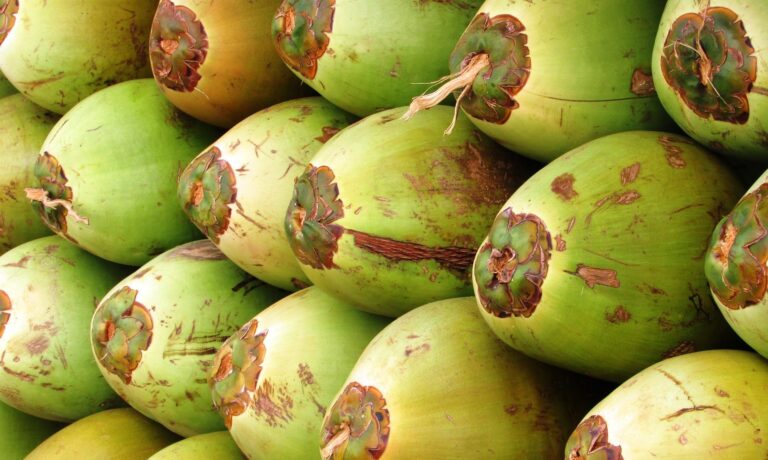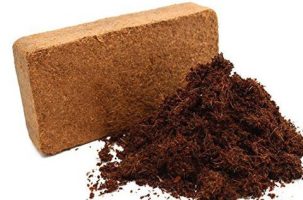What is coconut soil
Det lyder måske som et lidt dumt spørgsmål at spørge hvad kokosjord er, men det er det slet ikke. Kokosjord er ikke bare jord fra kokos, det er meget mere komplekst end som så. Det er faktisk slet ikke jord, der har nogle få ting til fælles med jord, som for eksempel hvordan det ser ud og at man kan gro planter i det, men så går lighederne faktisk ikke meget længere end det.
What is Coconut Soil Made of
Det er som man måske kan fornemme ud fra ordets opbygning, lavet af kokos-materiale, faktisk udelukkende af kokos, der er ingen andre stoffer tilføjet.
Coconut flour thus consists of leftover material from the production of things like coconut oil, coconut milk and so on. This means that it consists of the classic brown shell that you know from coconuts, but also the slightly softer green/yellow shell that you see in nature.
It is therefore an extremely sustainable residual product, according to many it is even the most sustainable growing medium.
Sustainability
There are several reasons why coconut soil is hailed as being very sustainable, the first of which we touched on just before is that it consists exclusively of residual material, i.e. material that would otherwise have simply been thrown out or burned.
The second reason is that coconut soil is relatively recyclable. After you have harvested, you can cleverly use your coconut soil again, for a new sowing, you can do this several times, and you can therefore enjoy your coconut soil for a long time. Furthermore, it is also a renewable resource, as there will always be coconut trees.
Sterile and disease-free soil
En konsekvens af bearbejdningsprocessen for kokosjord, er at det er nærmest fuldstændigt sterilt. Så selvom det ligner normal jord, er det modsat jord, helt umuligt at gro i kokosjord uden tilføjet gødning, der er altså ingen naturlige næringsstoffer i kokosjord.
This is both an advantage and a disadvantage, it means that you are forced to fertilize your plants yourself, but it also means that you are 100% in control of the nutrient composition.
The fact that it is completely sterile also means that it is completely free from harmful pestilences such as insects and plant diseases, which are found in normal sowing soil/prick soil, plant bags and garden soil.
Why you should start using coconut soil
Der er mange gode grunde til at begynde at bruge kokosjord. Den første grund er for at hjælpe miljøet, og for at lidt bedre samvittighed. Det er nemlig rigtig godt, men det er ikke noget mirakelmiddel.
There are several other alternative growing media that can also grow plants as quickly as coconut soil, however none of them are nearly as sustainable. Kokosfibrene is, among other things, very suitable as a substitute for it environmentally harmful use of sphagnum, which increases the emission of CO2.
How to use coconut soil
At bruge det som sit primære gromedie er ikke helt som simpelt som det er ved dyrkning med jord. Der er nemlig både nogle fordele og nogle ulemper der er med til at gøre det lidt anderledes at arbejde med.
When you receive your package with coconut soil, you can't just pour it into a pot and start planting your seeds, unfortunately it's not that simple.
Coconut soil is delivered in heavily compressed "bricks" of coconut fibers, so that it takes up as little space as possible to store, and to save on the environmental impact of transport.
Det komprimerede jord har en ekstremt høj sugevne. Med blot en “mursten” på omkring 650 gram kokosjord, kan du altså tilføje næsten 4 liter vand.
After you have left the water mixture for approx. half an hour, you will have approximately 9 liters of nice clean coconut soil ready for cultivation!
Add liquid plant fertilizer
Before you mix the water with the coconut soil, you should mix fertilizer into the water. We at plantelys.dk recommend that you use liquid fertilizer produced in Denmark Big Plant Science, but depending on the type of plant you want to grow, what is the optimal fertilizer can vary.
Water buffer
With the high content of water in the "soil", it is almost impossible for your plants to dry out (if you remember to water fairly regularly).
Because of the way coir absorbs water, water is always available, but it is "stored" in the coir, so you don't have to worry about your plants drowning in water.
Furthermore, coconut soil is highly oxygenated, which ensures that your plants create a stronger root network!!
Addition to garden soil
Hvis du føler at rent kokos jord er et lidt for stort et spring at tage, er det også muligt at blande det med ægte jord, som en tilsætning til din pottejord og havejord. Dette er en rigtig god teknik, som vi også anbefaler, da du på den måde for du mange af fordelene fra begge jordtyper, uden det føles for meget som en voldsom overgang.
Hydroponic cultivation
If you're very used to growing plants and vegetables with soil, but have a little dream inside you to start growing plants hydroponically, coco soil can also be a great start.
Coconut soil is in many ways a middle ground between conventional soil cultivation and hydroponics, so it is a good project to embark on if you would like to have a slightly smoother transition to hydroponics.
Who knows, you may also love coconut soil farming and stick with it!
For growing microgreens
Microgreens are also very suitable to be grown in coconut soil. Because microgreens are so small and so close to the ground, it is a huge benefit that the coconut soil is sterile so that you don't run the risk of "messing up" with your food when you harvest your microgreens.
If you have never heard of microgreens they are, in short, small and nutritious immature vegetable sprouts, they can be grown in a container or tray either in a kitchen or wherever you have space.
With a grow lights is it also possible to grow microgreens in dark rooms, such as the basement. Or as a nice edible decoration on your kitchen table, where it is grown with coconut mulch without harmful bacteria. We have many beautiful ones grolys lamps which you can have standing on your kitchen table.
Microgreens are also called "real superfoods" because they contain many more nutrients than fully grown vegetables. You can read more about growing microgreens in our blog here. Or you can see our selection of microgreen seeds and accessories
Summary list of pros and cons of growing with coconut soil
- Advantage
- Peat-free planting soil made from coconut fiber and coconut shell
- Much more environmentally friendly than both sphagnum and peat moss
- The most sustainable growing medium/growing medium beyond hydroponics
- Is a renewable resource, so the earth will never run out of it.
- Faster plant growth and larger harvest than with normal soil
- Is sterile and disease-free, and therefore very good for micro green
- Super good beginner's step in hydroponics
- Very high water retention properties
- Airy and therefore gives stronger roots
- Relatively simple and easy to grow in
- Can be reused to grow plants multiple times
- Low CO2 emissions
- Disadvantages
- Good price for growing microgreens, but for a whole plant bed it can be expensive.
- Bad coconut soil can contain a lot of salt due to the processing, but we only have high quality coconut soil
- Det er sterilt og uden næring, det er derfor absolut nødvendigt at gøde
- Det kan være svært at finde i de almindelige havecentre, men du kan nemt buy it here
- It may look like ordinary soil, which may confuse some.
- Easy, but more difficult than ordinary soil
If you need help or want to know more, you are more than welcome to contact our team of experts here







